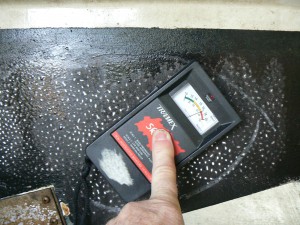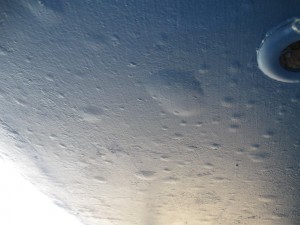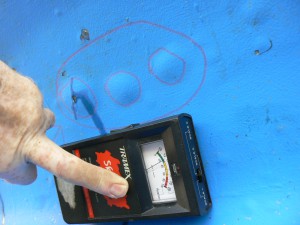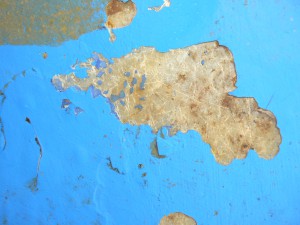OSMOSIS & WICKING
Picture 1 Sample – Small osmosis blistering showing a high moisture content reading
Very simply, the problem is caused by water penetrating the gelcoat and entering the laminated structure. This water takes in solution free chemicals salts and becomes denser than salt water on the outside of the hull. This creates a differential pressure and since water will not compress blisters form on the outer side of the gelcoat
Unfortunately the development of blisters is not predictable, some vessels may indicate high moisture content, suggesting the presence of blister fluid, but will not develop blisters for many seasons if at all, others may have similar readings with blisters present. It is generally accepted that osmotic blisters will not be found with ‘low’ meter readings – though this is not always true. Not all blisters are caused by osmosis, some will be found to be dry blisters, these may often appear in the gel coat and usually caused by aeration when the original batch of gel coat was mixed.
These swell with water and raise localised rashes on the gel coat which disappear after a short time ashore and usually of no consequence.
Blisters caused by osmosis particularly at the outset may not be easy to find, as they may not be very numerous and will be quite small, having the appearance of small pimples, on average they may reach fingernail size (approximately 10 mm diameter), in extreme cases these may reach hand palm sized or larger when many blisters merge and combine making very large individual blisters, although this is a rare occurrence on modern craft, and probably would have been attended to long before it had reached this size. Serious delamination would be a result of this extreme circumstance.
However, early treatment of osmotic boats in early stages tends to be less successful than treatments of vessels with advanced blistering.
Sample – Both small and large blistering
Experience has shown that the breakdown process in GRP laminates take some time to reach its conclusion, therefore if treatment is carried out prematurely, it is much more difficult to remove solutes from the laminate, and a reoccurrence of osmosis is much more likely to occur.
At the other extreme, a visual examination revealing extensive gel coat and deeper seated blisters may be all that is necessary to produce a diagnosis of “osmosis”.
Photo 1 – The first osmotic blister was burst giving off chemical-smelling (blister juice) liquid – quite often under pressure, being acid and breaks down the polyester in a process known as hydrolysis – being normally localized. The moulding as a whole will still retain most of its strength unless these current blisters become very much larger and much more extensive. NOTE The relatively low moisture meter readings obtained
Wicking: Wicking is where the individual strands of the fibreglass mat behave like straws and draw water along their length, in doing so they swell in size and wicking will quite commonly be identified by a very slight raised pattern of the original matting visible on the gel coat.
Very often as the water dries out the swelling diminishes and the pattern disappears. When looking at a gel coat without pigment, wicking is easily identified because the area affected will have many individual strands of fibreglass clearly visible with a white outline.
This white outline is where the bond has broken between the resin and each individual strand. This ‘wicking’ is an indication that there is moisture in the resin, and is often a precursor to or accompanies blistering.
Treatments:
Do nothing. On an old, heavily built boat, this is a genuine option. If there are no blisters I would definitely do nothing even if a moisture meter shows very high readings. If there are blisters but they are small and not too many they are not likely to have any significant effect on the structural strength
Local treatment. Cut or grind open individual blisters, repeatedly wash out with hot water or steam, to remove the ‘blister juice’ from any blisters, dry thoroughly and fill with epoxy paste (not car body filler).
Hugo du Plessis, author of what is virtually the standard reference work on GRP yachts, regards this as the best option in almost all cases, and says total gelcoat replacement (see below) should be an absolute last recourse.
Next winter you may have a few more blisters – usually in different places. The fact that they are usually in different places is a significant one – you are not getting blisters re-occurring but new ones developing.
Go to your local ‘Osmosis treatment centre’ and pay rather a lot to have the gelcoat removed, the hull washed and dried out, and the hull recoated with epoxy. The smaller and older the boat the less cost-effective this is. Treating an old river cruiser could cost almost £4 – 5,000 on a boat perhaps only worth £15,000.
On a 50-footer worth £150,000 the cost might be £8,000 – a far lower proportion of the boat’s value. Yards used to offer a five year warranty with this work – many no longer do so, or charge extra if you want the warranty (they buy insurance against claims).
Osmosis Protection Scheme Other protective measures that can be considered for ‘hull protection’ are to sheath with a water barrier such as International Gelshield 200 or VC Tar2 which is applied over existing gelcoat – however such applications cannot stop osmosis once it has started. Such applications if applied following the manufacturer’s instructions are usually successful and can greatly extend the useful life of the hull structure.
Acknowledgement: https://www.yachtsnet.co.uk/osmosis.htm
For more information contact European Marine Services Ltd. Marine Surveyors & Consultants
EMS also undertake Boat Safety Inspections & Engine Inspections
www.europeanmarinesurveys.com
Tel: 01603 327 123










